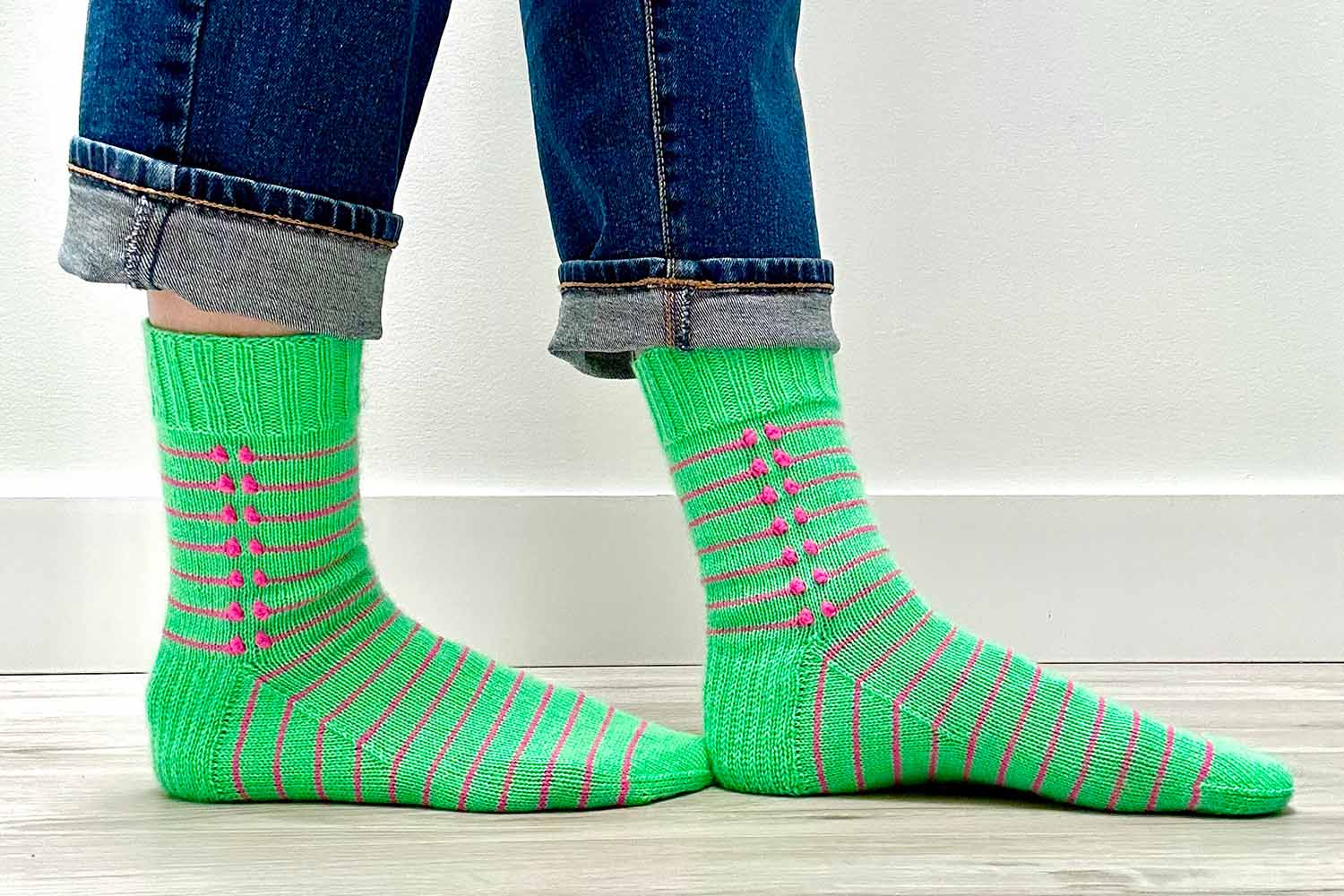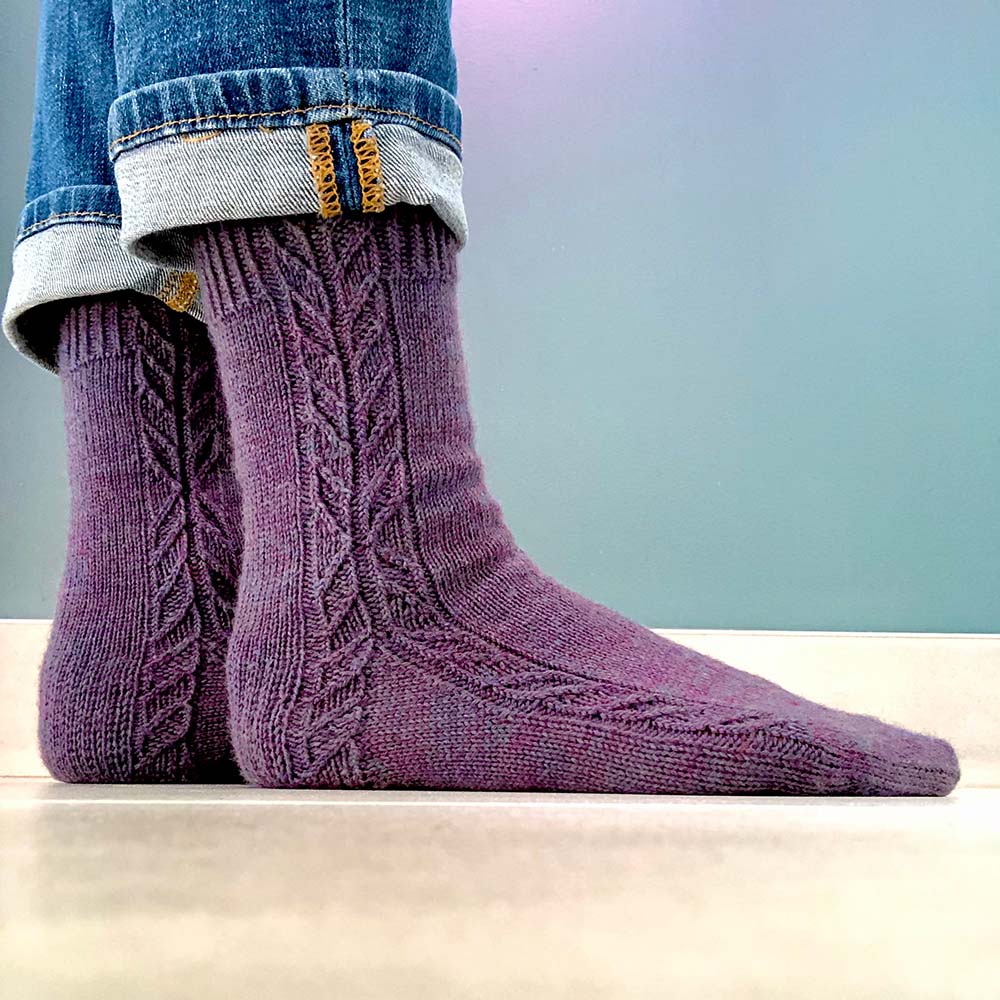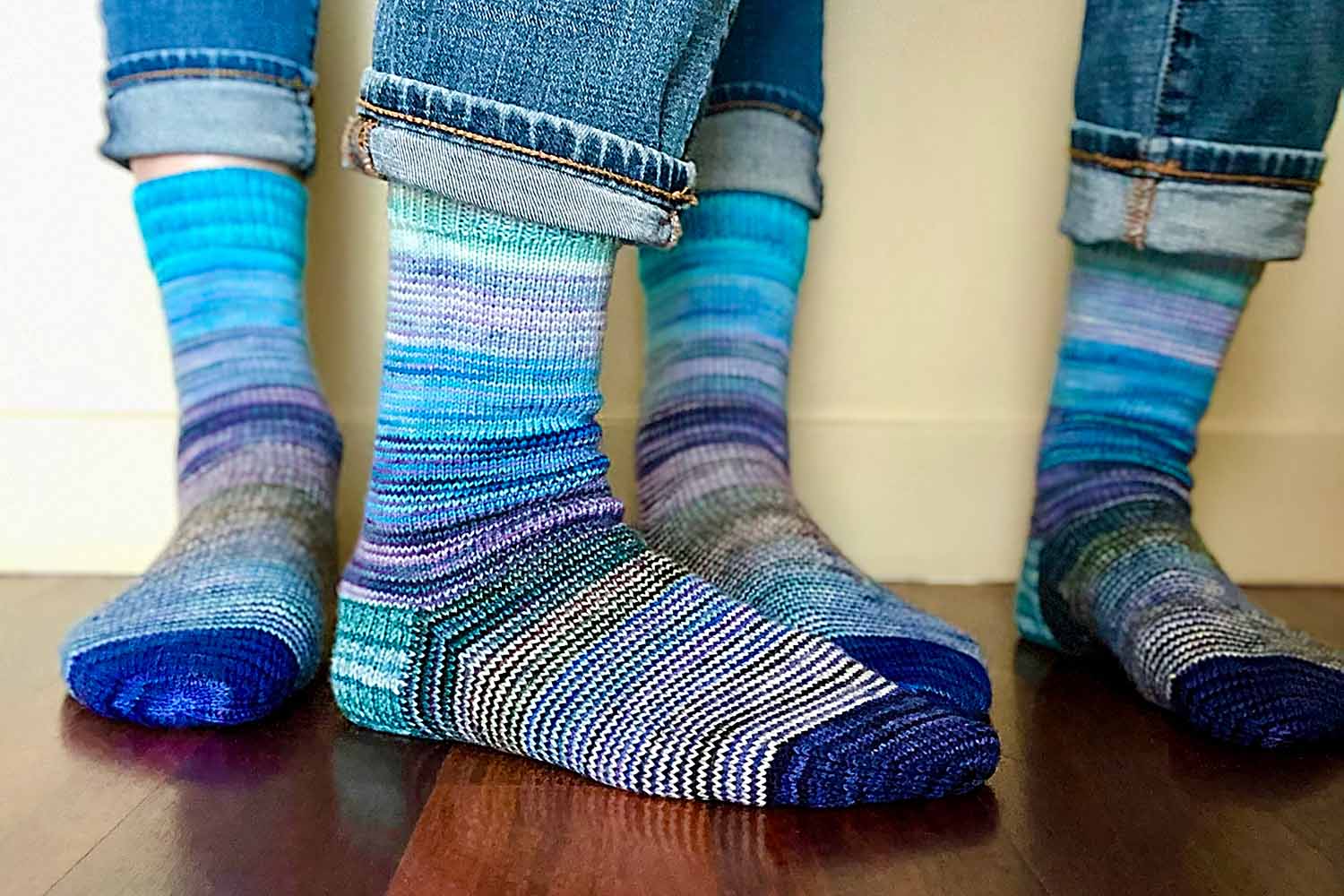Top 3 Sock Fit Problems
When it comes to sock knitting, fit is everything. A beautifully knit sock that doesn’t stay up or is too short won’t see much wear.
After teaching hundreds of knitters how to make socks, I’ve seen the same challenges pop up again and again.
No matter what kind of sock you’re knitting — toe-up or cuff-down, short rows or heel flaps, or even flat — the same three fit problems tend to trip people up:
- choosing the wrong size,
- not getting gauge,
- not customizing foot length.
Let’s walk through them so your next pair feels as good as it looks.

1. Choose the Right Size
THE BEST WAY to get the right fit is to measure the wearer’s foot circumference and choose a size based on that measurement.
Measure Foot
Foot circumference is measured around the ball of the foot (avoiding bunions) while standing with foot flat on the floor.
Socks need about 10% negative ease for a good fit. That means the target sock circumference is smaller than the foot circumference. Multiply the foot circumference measurement by 0.9 to calculate 10% negative ease. For most adults, it’s probably about 1″ / 2.5 cm smaller than the actual foot circumference. For children it ranges from ½” to ¾” / 1.5 to 2 cm smaller than foot circumference.
You should also take into account how stretchy or how thick the knitted fabric is, especially compared to stocking stitch. Stranded stitch patterns and slip stitch or mosaic stitch patterns tend to be less elastic and have a smaller inside circumference. Lots of cable crosses clustered together can be quite constricting, especially if they’re on the upper part of the sock that needs to stretch to allow the heel to pass. These stitch patterns would require less negative ease.
Decoding the Pattern’s Sizing
How sizes are presented in knitting patterns runs the gamut.

Pop Rox Sox
Sizes: Baby (Child, Preteen, Adult S, M)(Adult L, 1X, 2X, 3X)
Finished foot circumference: 4¾ (5¾, 6½, 7½, 8½)(9½, 10¼, 11¼, 12¼)” / 12 (14.5, 16.5, 19, 21.5)(24, 26, 28.5, 31) cm.
Finished foot length: 5 ¼ (6 ½, 7, 8 ¼, 9 ½)(10 ½, 11 ½, 12 ¾, 13 ¾)” / 13.5 (16.5, 18, 21, 24)(26.5, 29, 32.5, 35) cm.
Make sure you’re using the right measurement when selecting a size by looking for the following clues.
A. Finished measurements are provided either as the sizes or alongside the sizes. Compare your target circumference measurement (with negative ease) with those in the pattern. If you’re between sizes, size down to the smaller size.
B. Foot circumference or an unclear “measurement” is provided but it doesn’t say whether it’s the finished circumference or the actual foot measurement or what. Read the pattern instructions to find the stitch count around the foot (not including gusset stitches) and divide it by the pattern’s stitch gauge to get the finished measurement. Compare this number with your target measurement and size down if you’re between sizes.
C. Sock sizes are indicated by shoe size alone. Foot length dictates shoe size more than foot circumference does. Choose a size smaller for people who wear a narrow shoe size, or a size larger for people whose shoe size is wide.
D. No measurements are provided and sizes are offered as S, M, L or Women, Men or something similar. See B above.
E. Sizes are only offered by foot length. (I would be a little wary about possible misinformation in such a pattern.) See B above.

2. Gauge
While I understand many knitters choose not to knit gauge swatches, at the very least, measure your gauge after having worked about 4″ / 10 cm of the foot or leg section. This is practically the same amount of knitting as a decent gauge swatch.
If your gauge is off and you want the sock to fit, be ready to rip back and begin again. Either change needle size to get the right gauge or a customization is needed.
When you do knit a gauge swatch, it should be worked using the same needles and in the same manner as the sock, in-the-round or flat. A flat gauge swatch for a sock knit in-the-round has the potential to provide misinformation.
3. Customize Foot Length
You’ll need the sock wearer’s foot length measurement for the best fit. The foot length in a pattern is generally the “averaged” length for all feet that have the same circumference. Most of us aren’t average.

Finished sock length should be slightly shorter than measured foot length: about ¼” / 0.5 cm shorter for feet less than 7″ / 17.5 cm (children) and ½” / 1 cm shorter for feet more than 7″ / 17.5 cm (adults).
In the pattern instructions, often two measurements are offered at the point that will dictate foot length. You might see an instruction that says something like, “Work until foot measures 6 ½” / 16.5 cm from toe/back of heel, or until foot is 1 ¾” / 4.5 cm shorter than target foot length.”
In this case, the first measurement will result in an average foot length for that specific foot circumference. The second number is the golden key 🔑 for customizing foot length for your sock.
For example in my case, I have narrow feet and my foot length is 9 ½” / 24 cm. I subtract ½” / 0.5 cm negative ease from my foot length to get a target length of 9″ / 22. 5 cm.
Working from the line of instruction above, when I subtract that golden key 🔑 from my target foot length to customize the sock to my foot and I have to work 7 ¼” / 18 cm for that line of instruction.
If I had worked only 6 ½” / 16.5 cm as indicated, my sock would be ¾” / 2 cm too short.

A well-fitted sock isn’t about luck — it’s about a few thoughtful measurements, a quick check of your gauge, and a little customization. Fit stops being a guessing game and becomes part of the creative process. And honestly? There’s nothing more satisfying than a handknit sock that hugs your foot just right.

